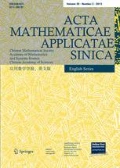Abstract
In this paper, we study structure-preserving algorithms for dynamical systems defined by ordinary differential equations in R n. The equations are assumed to be of the form ẏ = A(y)+D(y) +R(y), where A(y) is the conservative part subject to 〈A(y), y〉 = 0; D(y) is the damping part or the part describing the coexistence of damping and expanding; R(y) reflects strange phenomenon of the system. It is shown that the numerical solutions generated by the symplectic Runge-Kutta(SRK) methods with b i > 0 ( i = 1, • • • , s) have long-time approximations to the exact ones, and these methods can describe the structural properties of the quadratic energy for these systems. Some numerical experiments and backward error analysis also show that these methods are better than other methods including the general algebraically stable Runge-Kutta(RK)methods.
Similar content being viewed by others
References
Feng, K., Shang, Z.J. Volume-Preserving Algorithms for source-free systems. Numer. Math., 71: 451-463 (1995)
John Guckenheimer, Philip Holmes Nonlinear Oscillations, Dynamical systems and Bifurcation of vector fields. Springer-Verlag, New York, (1992)
Hairer, E., Lubich, C. Invariant tori of dissipatively perturbed Hamiltonian system under symplectic discretization. Applied Numerical Mathematics, 29: 57-71 (1999)
Hairer, E., Wanner, G. Solving Ordinary Differential Equations. Springer-Verlag, Berlin, 1991
Hairer, E., Lubich, C., Wanner, G. Geometric Numerical Integrating. Springer-Verlag, Berlin, 2002
Humphries, A.R., Stuart, A.M. Runge-Kutta methods For Dissipative And Gradient Dynamical System. SIAM. J. Numer. Anal., 31(5): 1452-1485 (1994)
Kirchgraber, U., Stiefel, E. Methoden der analytischen Störungsrechnung und ihere Anwendungen. Teubner Stuttgart, 1978
Lasagni Canonical RK methods. ZAMP, 399: 52–953 (1988)
Qin, M.Z., Li, H.W. Volume-preserving RK methods for linear systems. Acta. Math. Appl. Sinica, 16(4): 430–434 (2000)
Qin, M.Z., Zhu W.J. Volume-preserving schemes and Numerical Experiments. Comptuters Math. Applic., 26(4): 33–42 (1993)
Sanz-serna, J.M. RK schemes for Hamiltonian systems. BIT, 288: 77–883 (1988)
Sparrow, C. The Lorenz Equations. Springer-Verlag, New York, Heidelberg, Berlin, 1982
Sun, G. Structure-preserving algorithms for dynamical systems. Journal of Computational Mathematics, 20(6): 619–626 (2002)
Suris, Y.B. On the conservation of the symplectic structure in the numerical solution of Hamiltonian systems. In: Numerical solution of ODE, ed. s.s. Filippov, Keldsh Institute of Applied Mathematics, Vssr Academy of Science, Moscow, 6(4): 148–160 (1988)
Zhang, J.Y., Feng, B.Y. Geometric theory and bifurcation problem of ordinary differential equation. Peking University, Beijing, 1997 (in Chinese)
Author information
Authors and Affiliations
Corresponding author
Rights and permissions
About this article
Cite this article
Wang, Ls., Feng, Gh. Structure-Preserving Algorithms for a Class of Dynamical Systems. Acta Mathematicae Applicatae Sinica, English Series 23, 161–176 (2007). https://doi.org/10.1007/s10255-006-0361-0
Received:
Revised:
Issue Date:
DOI: https://doi.org/10.1007/s10255-006-0361-0




